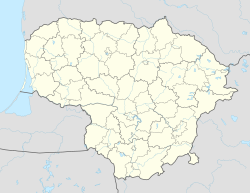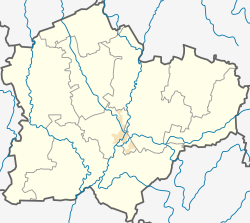Josvainiai
Josvainiai | |
|---|---|
Town | |
 | |
| Coordinates: 55°14′50″N 23°50′00″E / 55.24722°N 23.83333°E | |
| Country | Lithuania |
| Ethnographic region | Aukštaitija |
| County | |
| Municipality | Kėdainiai district municipality |
| Eldership | Josvainiai Eldership |
| Capital of | Josvainiai eldership |
| First mentioned | 1486 |
| Granted city rights | March 29, 1792 |
| Population (2021) | |
| • Total | 1,122 |
| Time zone | UTC+2 (EET) |
| • Summer (DST) | UTC+3 (EEST) |
Josvainiai (formerly Polish: Jaswojnie, Russian: Ясвойни, Ясвойне) is a small town in Kėdainiai district, central Lithuania. It is located on the Šušvė River 10 km southwest from Kėdainiai. The town comprises the Catholic All Saints Church, a gymnasium, a post office, a public library, a stud farm, and a culture house.[1]
History
[edit]The toponym Josvainiai probably derives from the unattested Lithuanian personal name *Josvainis.
Historians believe that there was a medieval castle in Josvainiai, attacked many times by the Teutonic Knights. In 1486 Josvainiai was mentioned as a town. During the 16th century the royal manor of Josvainiai and the first wooden church were mentioned. During the wars of the 16th–17th centuries Josvainiai castle was devastated by Swedes.[1][2]
The town was granted city rights and a coat of arms on March 29, 1792.[1] On July 19, 2006, the town was granted a renewed coat of arms by a presidential decree.
During the Soviet era Josvainiai was a center of a selsovet and kolkhoz.[2]
Jewish community
[edit]Jews first settled in Josvainiai in the 17th century. By 1897, 534 Jews lived in the town, constituting 40% of the total population.[3] There was a synagogue and a Jewish school. Most Jews were expelled during World War I. In their absence, a large portion of the town burned down. After the War, some returned. Before The Holocaust, the Jewish population was 270 and included about 70 families.[4] They lived around the marketplace and on nearby streets. During World War II, 282 Jews were murdered in a mass execution: 86 men, 110 women, and 86 children.[5][6]
Demography
[edit]
|
|
|
| ||||||||||||||||||||||||||||||||||||||||||||||||||||||
| Source: 1902, 1923, 1959 & 1970, 1979, 1989, 2001, 2011 | |||||||||||||||||||||||||||||||||||||||||||||||||||||||||
Images
[edit]-
A mausoleum in the Josvainiai cemetery
-
Šušvė in Josvainiai
-
Josvainiai town center
-
Bus stop of Josvainiai (now destroyed)
References
[edit]- ^ a b c "Josvainiai". Visuotinė lietuvių enciklopedija (in Lithuanian). Vol. 8. Vilnius: Mokslo ir enciklopedijų leidybos institutas. 2005. p. 732. Retrieved December 20, 2020.
- ^ a b "Josvainiai". Tarybų Lietuvos enciklopedija (in Lithuanian). Vol. 2. Vilnius: Vyriausioji enciklopedijų redakcija. 1986. p. 135.
- ^ Shmuel Spector,ed, The Encyclopedia of Jewish Life Before and During the Holocaust, New York University Press, 2001, p578
- ^ Schoenburg, N&S: Lithuanian Jewish Communities, Northvale, New Jersey, 1996
- ^ "Collections Search – United States Holocaust Memorial Museum Search Results".
- ^ "Pinkas Hakehillot Lita: Josvainiai".








